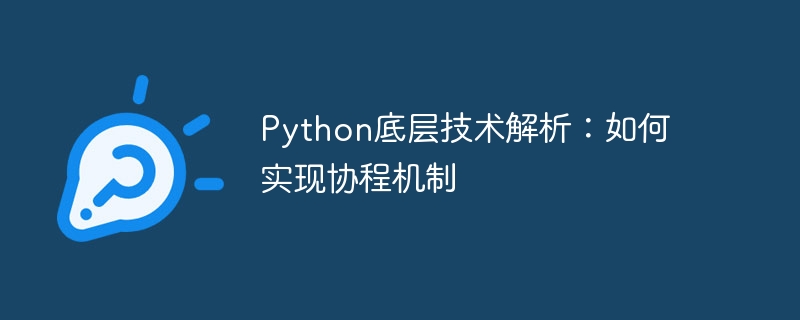

Analysis of Python's underlying technology: How to implement the coroutine mechanism
Introduction:
With the development of computer software and hardware, there is an increasing need to improve program execution efficiency urgent. In a multi-threaded and multi-process environment, the coroutine mechanism has gradually become one of the important means to improve program performance and concurrency capabilities. This article will introduce the concepts and principles of the coroutine mechanism, and explain in detail how to use Python to implement the underlying technology of coroutines.
1. Overview of coroutine mechanism
Coroutine is a more lightweight concurrency control structure than threads. It can switch multiple subtasks within a thread. Compared with threads, coroutines have the following advantages: no overhead of context switching and thread synchronization is required, and they occupy less memory and CPU resources.
The coroutine mechanism can implement a more efficient concurrency model and achieve concurrent execution of tasks by switching between tasks. In the coroutine, each task is switched through the coroutine scheduler. The coroutine scheduler selects the next task to be executed according to a certain scheduling algorithm, so that the task can save the current execution status when switching so that it can be restored later. Continue execution to the state before switching.
2. Implementation of Python coroutine mechanism
After Python version 3.5, new syntax keywords for the coroutine mechanism were introduced: async and await. By using these two keywords, coroutine tasks can be easily defined and scheduled.
async def syntax to define a coroutine task. A coroutine task is a function that can be switched by the scheduler. The code inside the function can switch tasks through the await keyword. The following is a sample code for a simple coroutine task:
import asyncio
async def coroutine_example():
print("Start")
await asyncio.sleep(1)
print("End")
# 调用协程任务
asyncio.run(coroutine_example())asyncio The scheduler provided by the module implements the scheduling of coroutine tasks. The scheduler is the management and scheduling center of coroutine tasks. It is responsible for selecting the next task to be executed according to the scheduling algorithm, switching between tasks and saving execution status. The following is a simple scheduler sample code:
import asyncio
async def coroutine_example():
print("Start")
await asyncio.sleep(1)
print("End")
# 创建调度器
loop = asyncio.get_event_loop()
# 将协程任务加入调度器中
loop.run_until_complete(coroutine_example())
# 关闭调度器
loop.close()Queuequeue to achieve this. Queue is a thread-safe queue module that can implement asynchronous communication between multiple coroutines. The following is a simple sample code for inter-coroutine communication:
import asyncio
# 创建一个共享队列
queue = asyncio.Queue()
async def producer():
for i in range(5):
await queue.put(i)
print(f"Producer put: {i}")
await asyncio.sleep(1)
async def consumer():
while True:
item = await queue.get()
print(f"Consumer get: {item}")
await asyncio.sleep(0.5)
# 创建调度器
loop = asyncio.get_event_loop()
# 将协程任务加入调度器中
loop.run_until_complete(asyncio.gather(producer(), consumer()))
# 关闭调度器
loop.close()The above sample code shows how to use Python's asyncio module to implement the coroutine mechanism . By defining coroutine tasks, using a scheduler to schedule tasks, and implementing communication between coroutines, we can easily write efficient concurrent programs.
Conclusion:
The coroutine mechanism is an important technology for improving program performance and concurrency capabilities. It can switch multiple subtasks within a thread, reducing the overhead of context switching and thread synchronization. Python provides the async and await keywords, as well as the asyncio module to implement the underlying technology of coroutines. By learning and using the coroutine mechanism, we can write more efficient concurrent programs and improve program execution efficiency and performance.
The above is the detailed content of Analysis of Python's underlying technology: how to implement the coroutine mechanism. For more information, please follow other related articles on the PHP Chinese website!




